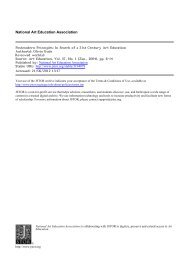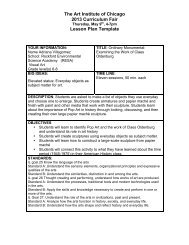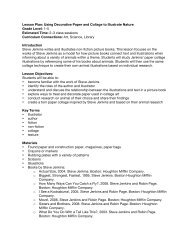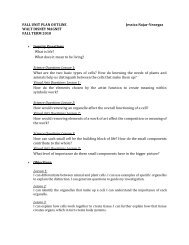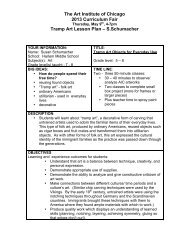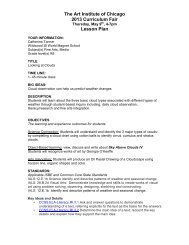Lesson 1 - LearningThroughMuseums
Lesson 1 - LearningThroughMuseums
Lesson 1 - LearningThroughMuseums
You also want an ePaper? Increase the reach of your titles
YUMPU automatically turns print PDFs into web optimized ePapers that Google loves.
● Advance Preparation<br />
• Prepare to display the reproduction of the painting The Last of New England—The Beginning<br />
of New Mexico as well as reproductions of The Herring Net and Distant View of Niagara Falls<br />
in the classroom for student viewing.<br />
• Review the Background Information section of this lesson about The Last of New England—<br />
The Beginning of New Mexico.<br />
● Vocabulary<br />
adjective<br />
compare<br />
contrast<br />
environment<br />
express<br />
interpret<br />
mood<br />
Southwest<br />
● Procedure<br />
Part 1: Interpret<br />
1. Ask students what they know about the western United States.<br />
2. Then ask what they would put into a painting to show it.<br />
3. Display The Last of New England—The Beginning of New Mexico. Ask students what they<br />
notice first.<br />
4. Ask students to identify what they think are important parts of the painting, such as the clouds<br />
or hills, and discuss why the artist might have painted them the way he did.<br />
5. Explain that the artist exaggerated lines and colors in order to express his feelings about the<br />
landscape with the painting.<br />
6. Ask how the painting makes them feel. Explain that a painting has a mood just as a story or<br />
poem does and that the artist paints it in ways to emphasize that mood.<br />
7. Have students make a “word picture” of the painting. Students should write adjectives and<br />
nouns on small pieces of paper and then place them on a sheet of paper on which they construct<br />
the painting with words such as “white,” “billowing,” and other adjectives that describe the<br />
clouds, or “curved,” “brown,” “striped” and other words that describe the landform.<br />
Part 2: Compare and Contrast<br />
1. Explain that the artist painted this after he moved from the East of the United States to the<br />
Southwest.<br />
2. Next, ask what the environment in the Northeast is like. Display the two paintings from<br />
<strong>Lesson</strong> 3 about the Northeast and have students identify specific characteristics of<br />
the environment. Ask what the mood is of each of the paintings—and what the artists included<br />
in order to express that mood. They can refer to specific details in the paintings or to the way<br />
the artists used color, line, or any other artistic element.<br />
52 • <strong>Lesson</strong> 3: People and Environments of the American West



